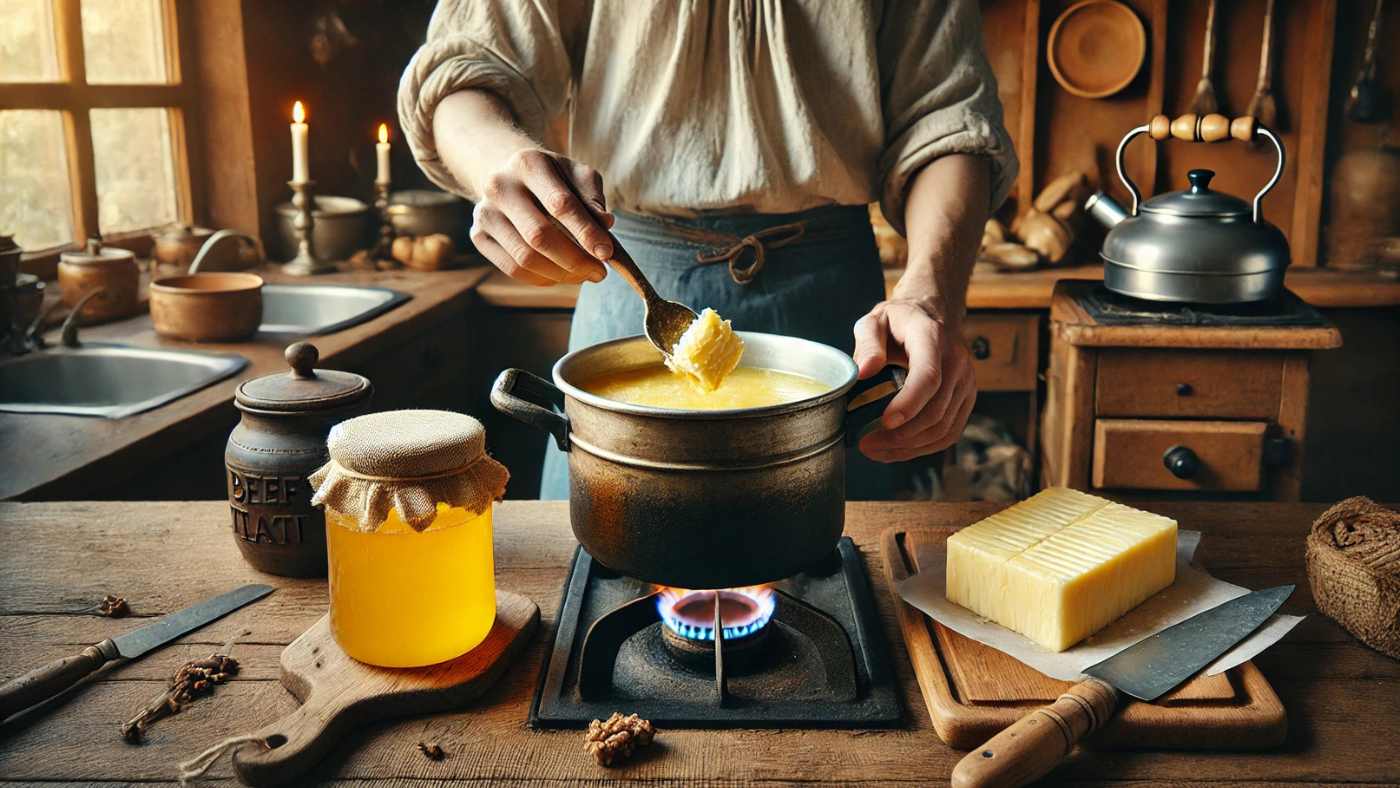Master the Art of Rendering Beef Tallow: Easy DIY Process for Beginners

Browning beef fat has been done since time began.
It is the process of rendering beef fat into a stable fat used for cooking and producing skincare products, among other uses.
The ability to render beef fat comes in handy when following a keto or paleo diet, running low on groceries, or using traditional fats.
Here is a tutorial on rendering beef tallows in your kitchen so that your fat is clean, smellless, and ready to use.
What Is Beef Tallow?
Beef tallow is fat originating from beef.
It is better than suet and is found around the kidneys of a particular animal (1).
As has been seen, grease, like butter or lard, is a beneficial cooking fat after congesting.
It can be used for frying, cooking in a pan, or even massaging the skin.
Light beef fat contains vitamins A, D, and E and is healthy and conducive to diet fats.

How to Render Beef Tallow: Step-by-Step Guide
Rendering beef fat might sound like a big deal, but it’s not rocket science, and anybody can do it at home with just a few simple tools.
Here’s how:
Gather Your Supplies
Before starting, gather the following tools and ingredients:
- Beef Fat (Suet): You need suet or other beef fat trimmings.
- Sharp knife: Butter these portions into small pieces.
- Slow Cooker or Heavy Pot: A UAslow cooker is best, but a large, heavy-bottom pot can also be used if you don’t own a UAslow cooker.
- Cheesecloth: For straining the tallow.
- Glass Jars: These are known to contain the fat once rendered.
- Preparation: Trim and Cut the Fat
This has to be done parallel with a knife to minimize the amount of meat or loose connective tissues on the fat.
The lower the level of these entries, the purer the fat and your pork will be. It’s also cut into small pieces to melt properly and uniformly.
When using a mechanical meat grinder, it is advised to cut the fat into smaller pieces in order to speed up the rendering process.

Begin the Rendering Process
There are two primary methods to render beef tallow: their method was the stovetop method and the slow cooker method.
We’ll cover both:
Stovetop Method: Sometimes, they place the fat in an extensive, heavy-base, over-low, overflow food preparation pan so as not to incorporate other food. The fat begins to melt gradually. Depending on the amount of fat melted, this may take a couple of hours.
Slow Cooker Method: If you want to approach the preparation more relaxedly, place the chopped fats in the slow cooker. Lower the heat and simmer for 4-6 hours, stirring occasionally so that you do not burn the fat.
That is why the operating procedure is intended to remove all the fat and leave only the solid tissue or residues. When the beef acquires the right texture, the fat will be tender, and you can proceed.

Strain and Store Your Tallow
However, once the fat is cooked, the pot is ready for filtering as soon as the last of the cracklings are skimmed off.
Here's how to do it:
- Spoon the melted tallow onto cheesecloth placed on a filter, and with the hand exerting as much pressure as possible, pour the melted tallow through the cheesecloth into a clean bowl. Ordinarily, the cheesecloth should be placed at the base of the container to strain out chunked meat that has not fully dissolved and rejected liquid fats.
- Once fried, they should cool slightly before you bottle the fat into jars. It will set to a thick, creamy white-colored paste like that in Rogan when it cools.
- Since fat is created through a vastly longer cooking process, unprocessed fat can be stored for about one year. When rendered, it needs to be kept dry and cool in an airtight container. It may also be kept in the refrigerator or frozen to extend the shelf life of the produce.
Benefits of Using Beef Tallow
- Healthier Cooking Alternative: Tallow is one of the finest natural resources of fats in foods. Its high smoking point makes it ideal for frying or roasting (2).
- Eco-Friendly: It should also be noted that the benefits derived from rendering beef fat are all the more considerable since you are rendering parts of the animal that people would not consume anyway (3).
- Natural Skincare: The fat may be utilized to make balms or lotions from scratch, maybe candles, or it can be hand-mixed (4).
- Budget-Friendly: It is way easier to make the fat at home than buy it if you get it from the local butchery (5).
Final Verdict
Tallow is cheap, simple to prepare, and does not need complicated equipment, but it has a wide range of applications. It is healthier for frying, so you should bring this product home to moisturize beef skin.
In addition, you will reduce the loss incurred on the expenditure on food that you prepare and realize your knowledge of a concept that is as old as civilization. Give it a go and use this all-natural fat anywhere you can think of!
💪Are you prepared to make beef tallow? Get your beef fat, and then let’s start! 🥩
FAQs
Which type of fat is used when rendering tallow?
Suet is the fat around cattle kidneys, and it is advised that it be used in the rendering of tallow. It’s very fine, and especially after cycles of five melts, it produces a very clean material.
Can beef fat be left at room temperature?
Nevertheless, beef tallows rendered and stored below airtight conditions should be good enough to last the year at an average temperature. We recommend placing the product in the refrigerator or the freezer for even longer storage. On the temperature
What are some of the uses of beef tallow?
Beef tallow can be cooked, fried in skincare and soaps, and used in candle making. I would like to know what beef fat tastes like. There is no photo description available. The beef fat I used was neutral in taste and did not interfere with sweet or savory recipes.
Are animal fats, particularly beef, better for your health than vegetable oil?
Yes, beef fat is utilized better than many processed vegetable oils; it contains principally natural, stable, and non-trans fats.
Research Studies
1. Title: The Role of Beef and Beef Tallow, an Enriched Source of Stearic Acid, in a Cholesterol-Lowering Diet
This study discusses the nutritional profile of beef fat, highlighting its content of fat-soluble vitamins A, D, E, and K and its role in dietary fat absorption.
Link: https://pubmed.ncbi.nlm.nih.gov/7977148/
2. Title: Comparative effects of animal fats and vegetable oils on health
This study compares the health impacts of natural animal fats like beef tallow with processed vegetable oils, emphasizing tallow's high smoke point and stability for cooking.
Link: https://www.ncbi.nlm.nih.gov/pmc/articles/PMC7071039/
3. Title: Sustainable Meat Processing: Waste Reduction through Rendering
This research explores sustainability practices in meat processing, mainly how rendering animal fats like beef tallow reduces waste in the meat industry.
Link: https://www.sciencedirect.com/science/article/pii/S0959652619317880
4. Title: The Benefits of Animal Fats in Natural Skincare Products
This study analyzes the effectiveness of beef fat in skincare formulations, focusing on its moisturizing properties and compatibility with human skin.
Link: https://onlinelibrary.wiley.com/doi/full/10.1111/ics.12656
5. Title: Stability and Shelf Life of Rendered Animal Fats
This research examines the shelf life and stability of rendered animal fats, including beef tallow, when stored in airtight containers at room temperature.
Link: https://www.sciencedirect.com/science/article/pii/S0308814619300479
